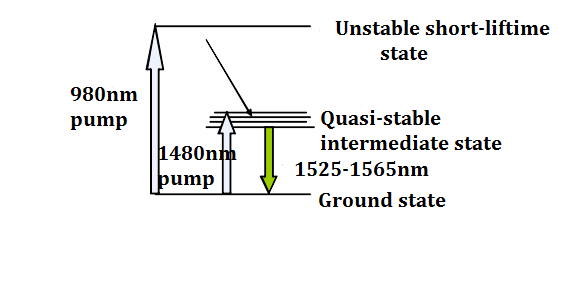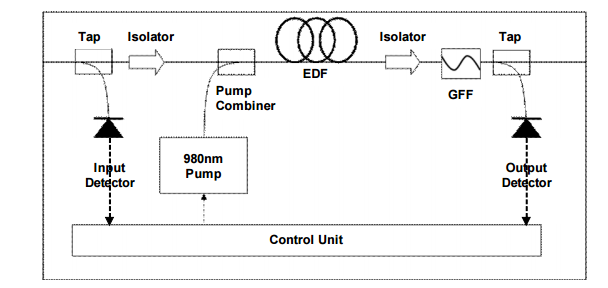Optical amplifiers are the critical technology for the optical communication networks, enabling the transmission of many terabits of data over distances from a few hundred kilometers to thousands of kilometers by overcoming the fiber loss limitation. As the first optical amplifier commonly used in optical communications systems, EDFA has resulted in a dramatic growth in transmission capacity with the deployment of WDM systems. Be equipped with the features of high output power, high gain, wide bandwidth, polarization independence and low noise figure, EDFAs have become one of the key components used in the new-generation optical communication system. So what is EDFA? Do you know EDFA working principle?
What Is EDFA?
Erbium-doped fiber amplifier (EDFA) is an optical repeater device that is utilized to boost the intensity of optical signals being carried through a fiber optic communications system. An optical fiber is doped with the rare earth element erbium so that the glass fiber can absorb light at one frequency and emit light at another frequency.
EDFA Working Principle
The erbium-doped fiber (EDF) is at the core of EDFA technology, which is a conventional silica fiber doped with Erbium. When the Erbium is illuminated with light energy at a suitable wavelength (either 980 nm or 1480 nm), it is motivated to a long-lifetime intermediate state, then it decays back to the ground state by emitting light within the 1525-1565 nm band. The Erbium can be either pumped by 980 nm light, in which case it passes through an unstable short lifetime state before rapidly decaying to a quasi-stable state, or by 1480 nm light in which case it is directly excited to the quasi-stable state. Once in the quasi-stable state, it decays to the ground state by emitting light in the 1525-1565 nm band. This decay process can be stimulated by pre-existing light, thus resulting in amplification. EDFA working principle is shown in the Figure 1.
Figure 1: EDFA working principle.
Baisc configuration of EDFA
EDFA configuration is mainly composed of an EDF, a pump laser, and a component (often referred to as a WDM) for combining the signal and pump wavelength so that they can propagate simultaneously through the EDF. In principle, EDFAs can be designed such that pump energy propagates in the same direction as the signal (forward pumping), the opposite direction to the signal (backward pumping), or both direction together. The pump energy may either be 980 nm pump energy, 1480 nm pump energy, or a combination of both. Practically, the most common EDFA configuration is the forward pumping configuration using 980 nm pump energy, as shown in the Figure 2.
Figure 2: The EDFA configuration with 980 nm pump energy
Application of EDFA
After learning what is EDFA, and EDFA working principle. Next, we’ll discuss application forms and application fields of EDFA.
- Booster Amplifier
When used as the booster amplifier, EDFA is deployed in the output of an optical transmitter to improve the output power of the multi-wavelength signal having been multiplexed, as shown in Figure 3. In this way, distances of optical communication transmission can be extended. This application form places a demand of higher output power on EDFA.
Figure 3: The booster amplifier
- Preamplifier
When used as the preamplifier, EDFA needs the features of low noise and high gain. Being equipped with these features, EDFA can significantly improve the sensitivity of an optical receiver when deployed in the input of an optical receiver, as shown in Figure 4.
Figure 4: The preamplifier
- Line Amplifier
When used as the line amplifier, EDFA is able to periodically compensate for the transmission loss of lines. As a substitute for OEO repeater, EDFA can directly amplify the optical signals transmitted in lines. In this way, we solve the bottleneck problems of photoelectric interchange to lay a foundation for all-optical network (AON). Figure 5 shows this application of EDFA.
Figure 5: The line amplifier
EDFA has the following fields of application:
(1) EDFA can be employed in the high-capacity and high-speed optical communication system. The application of EDFA is very constructive to deal with the problems of low sensitivity of receivers and short transmission distances owing to a lack of OEO repeater.
(2) EDFA can be utilized in long-haul optical communication system. By utilizing EDFA, we can dramatically lower construction cost by increasing the repeater spacing to reduce the quantity of regenerative repeaters. The long-haul optical communication system mainly includes the land trunk optical transmission system and the submarine optical fiber cable transmission system.
(3) EDFA can be used in the optical fiber subscriber access network system. If the transmission distances are too long, EDFA will function as the line amplifier to compensate for the transmission losses of lines, thus greatly increasing the number of subscribers.
(4) EDFA can be employed in wavelength-division multiplexing (WDM) system, especially dense wavelength-division multiplexing (DWDM) system. Utilization of EDFA in WDM system is able to solve the problems of insertion loss and reduce the influences of chromatic dispersion.
(5) EDFA can be utilized in community antenna television (CATV) system. In CATV system, EDFA functions as the booster amplifier to greatly improve the input power of an optical transmitter. Utilizing EDFA to compensate for the insertion loss of optical power splitters can significantly enlarge the scale of the distribution network and increase the number of subscribers.
Conclusion
From the above, we have a good understanding of EDFA, including EDFA working principle and its application. Of the various technologies available for optical amplifiers, EDFA technology is by far the most advanced. Nowadays EDFA is extensively in the optical fiber communication networks. As communication technologies continue to be developed, EDFA will become the preferred choice for the future optical amplifiers. Being equipped with the features of flat gain over a large dynamic gain range, low noise, high saturation output power and stable operation with excellent transient suppression, EDFA will play a more and more important role in optical communication system to better serve subscribers.
Related Articles:
Optical Amplifier – EDFA (Erbium-doped Fiber Amplifier) for WDM System
Differences Between Pre-Amplifier, Booster Amplifier and In-line Amplifier





